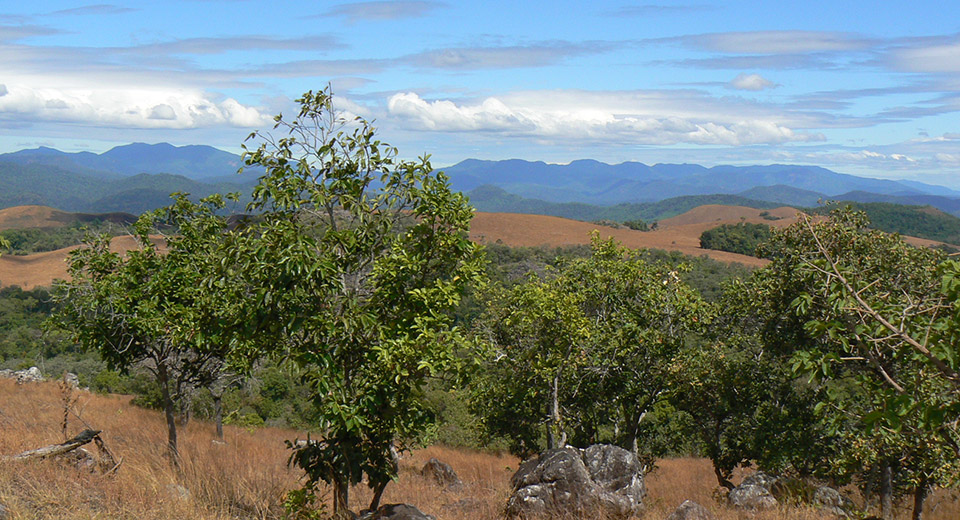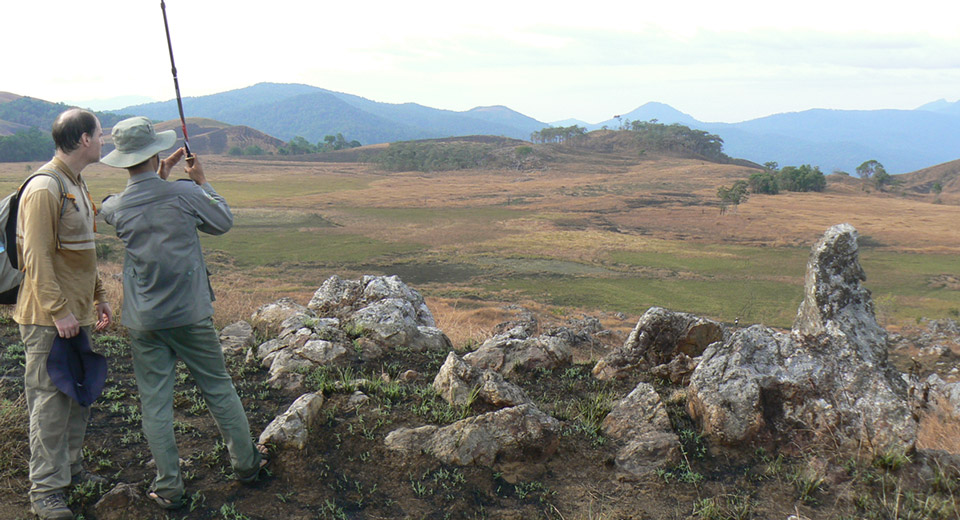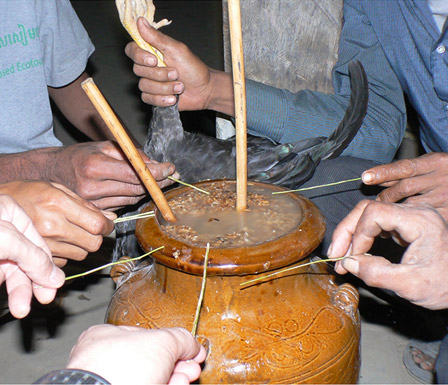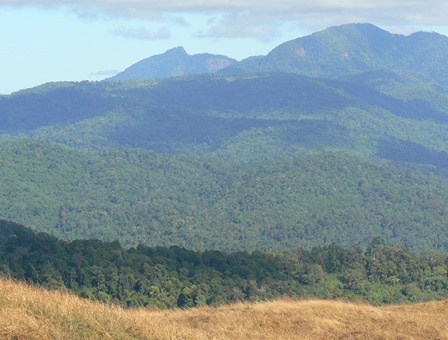Site Description
The mountainous Virachey National Park (VNP) is Cambodia’s largest protected area. Located in the Stung Treng and Ratanakiri provinces in the extreme northeast of the country, it is home to rare flora and fauna. Numerous groups of highlander tribes traditionally inhabit the park’s buffer zone, such as the Brao, Kreung, and Kavet. They are legally allowed to fish, hunt non-threatened species such as wild pigs, and collect non-timber forest products within the park’s boundaries. They consider the largest mountains "Spirit Mountains". These and other sacred natural sites are surrounded by a rich animist folklore the details of which vary between villages and tribes.
Ecology and Biodiversity
The park consists of upland savannah, semi-evergreen lowlands, montane forests, bamboo thickets and mixed deciduous forest. The majority of the park lies above 400 meters with the highest peak of spirit mountain Haling-Halang at 1,475 meters. Wild animals include Asian Elephants, Clouded Leopards (Neofelis nebulosa), Gaur (Bos gaurus), and numerous species of primates such as the threatened Red-shanked Douc Langur (Pygathrix nemaeus). Local rumours even suggest presence of species listed as extinct.
Threats
The main threats to the local ecosystems are rapid deforestation and land- appropriation due to the government’s policy of selling Economic Land Concessions, used as rubber and cashew plantations. The expansion of such concessions is fast and it aggressively tears through the remainders of Cambodia’s wild places and animist cultures. Likewise, hydropower development in the region, destined for urban regions reduces rivers to stagnant pools of contaminated water.
Related to this is the trend that young inhabitants of the region forget ancient traditions, tempted to adopt modern life styles. In fact, some seem to shun their animist heritage altogether.
Custodians
Mountains are considered the abode of powerful deities who can bring rain in times of drought, heal ill family members, and even spring incarcerated people from prison. The Brao people, resident in the buffer zone, are fearful of the Spirit Mountains of Virachey. They are particularly nervous about Haling-Halang, which sometimes demands human sacrifice in exchange for favours. No hunting or logging is allowed on Haling-Halang. Visitors to certain sites must make prayers to the resident spirits. Those who wish to collect this bamboo must consult with a local “magic man” who will get in touch with the spirits to find out exactly how much bamboo can be taken, and which sacrifice will be needed. The story goes that a young Brao man once cut a Haling-Halang bamboo without consulting a “magic man”. While cutting, a sharp piece of bamboo pierced his leg. The injury nearly killed him. These animist ways, illustrative also for different sites, indirectly result in wildlife protection.
Do Yok informed me that the Tampuan villagers who felled the tree did so at the urging of Vietnamese buyers –distant forces who do not live in nor understand this particular bioregion who nonetheless have a serious negative impact on it.“Do you see the cut tree there? That was done by minority people. This angered the spirits at the sacred lake, who then killed several people from the minority village where the loggers came from, and all the people from the village had to move out of the area. Even now, minority languages cannot be spoken in the park, or the people who speak it will fall ill and die very quickly.”
- from “Animism in Cambodia: Bioregionalism in Practice” in The Trumpeter, Vol 27 No 1 (2011) 8-22 by Gregory McCann.
Vision
There is still time to save the parks cultural and natural heritage. The area would be benefitted with the establishment of a coalition of communities in the buffer zone who earn money as tour guides, hosts, agriculturalists, fishermen, and other contemporary professions, without abandoning their animist heritage. Intercultural transmission from the elders to the younger generation needs encouragement, reinforced by transmission across tribes. Young people can drive scooters, talk on cell phones, work in town, and also be proud of their rich animist heritage.
Action
Grassroots efforts are underway. A camera-trapping project on Haling-Halang aims to verify the presence of critically endangered species in the park and to involve indigenous people, Park rangers, NGO workers, and tour operators in a coordinated effort to protect the sacred mountains. Storytelling sessions and trekkings to sacred mountains educate tourists as well as young local people, enabling them to learn the remaining animist legends. Ethnographic interviewing generates insight into the situation, also helping to raise global awareness about the value of these lands.
Policy and Law
Indigenous people are legally allowed to fish, collect non-timber forest products, and hunt non-threatened species such as wild pig and jungle fowl. They did not traditionally hunt protected species such Pangolin but with high-paying markets in Vietnam, the temptation to earn money is now too great for some.
The park has been well protected between 2004 and 2008, when sponsorship of the World Bank enabled execution protective laws. Sponsorship was cancelled when the Cambodian government announced allowance to explore the park for valuable minerals. It has resulted in extensive logging, poaching, and encroachment. Roughly one third of the park is now business property. A temporary moratorium is currently in place.
Working together
So far, collaboration between different parties in this area is poor. Even among villages, the social fabric is beginning to fray as land is sold or illicitly signed over to outsiders. The Cambodian government is listed among the most corrupt in the world. There is nevertheless involvement of the NGO Habitat ID, and several universities do work in the region. This offers hope, but a lot of work remains to be done.
Conservation tools
To conserve nature in this area means to reinforce the traditional nature friendly ways of life. “Animistic Ecotourism” is the central concept encompassing these efforts, including storytelling sessions and trekking tours. Furthermore, research and documentation of the traditions and the important natural features in the park enables outsiders such as policy makers to become aware of its remaining value. Cultural documentation is currently done with ethnographic interviews. Motion-triggered camera-trapping on sacred mountains will soon be initiated in order to verify claims about the natural values of the area, such as the continued existence of rare and locally extinct species.
Results
Next to numerous academic publications that have been written about the region, efforts have established an expansive and reliable network of informants and translators who have visited many villages in the VNP buffer zone, and are now quite knowledgeable on the traditions. They could be the next important advocates for the rights of the region, when it comes to convincing key stakeholders.
In the near future, Habitat ID will print a book containing myths and legends of the spirits in the region. This will be dispersed through the region’s villages. Finally, a volunteer camera trap project is about to dawn as a result of long effort.
“The Bunong People love the forest and want to protect it,” Nach began. “Our traditional religion is good for the forest. If we respect the forest then the forest can give us everything we need. Everything. But if we do not respect the forest, then the forest will die, and we will all get sick.”
- from Called Away by a Mountain Spirit (2013, Dr. Cicero Books, p. 87) by Gregory McCann.
- Baird, Ian G. “Identities and Space: The Geographies of Religious Change amongst the Brao in Northeastern Cambodia.” Anthropos 104 2009: 457-468” 2009.
- “Controlling the Margins: Nature Conservation and State Power in Northeastern Cambodia.” Development and Dominion: Indigenous Peoples of Cambodia, Vietnam and Laos. Frederic Bourdier (ed.) White Lotus Press: Bangkok. 2009.
- Bourdier, Frederic. Ratanakiri: The Mountain of Precious Stones. 2006
- “When the Margins Turn One’s Step to an Object of Desire.” in Living on the Margins. Center for Khmer Studies: Phnom Penh. 2009
- Development and Dominion. White Lotus Press: Bangkok. 2009.
- Buckley, Ralf. “Parks and Tourism” in Ecotourism and Sustainable Tourism: New Perspectives and Studies. Apple Academic Press: New York. 2011.
- Davis, Wade. perf. Dreams of Endangered Cultures. TED. Monterrey, 2007. Presentation.
- De Soto, Hernando. The Mystery of Capital. Black Swan: London. 2000
- Hammer, Peter J.“Development as Tragedy: The Asian Development Bank and Indigenous Peoples in Cambodia” in Living on the Margins. Center for Khmer Studies: Phnom Penh. 2009.
- Ironside, Jeremy.“Development—In Whose Name?” in Living on the Margins. Center for Khmer Studies: Phnom Penh. 2009
- McCann, Gregory. Called Away by a Mountain Spirit. Dr. Cicero Books: New York. 2013.
- “Bioregions and Spirit Places: Taking up Jim Dodge’s Long-Lost Suggestion.” The Trumpeter 27.3 (2011): 10-26.
- White, Joanna.“The Indigenous Highlanders of the Northeast: An Uncertain Future.” in Ethnic Groups in Cambodia. Ed. Hean Sokham. Phnom Penh: Center for Advanced Study. 2009.
- Global Witness. “Rubber Barons”
- HabitatID: http://habitatid.org/
- Dr. Gregory McCann: greg.mccann1@gmail.com - Chang Gung University, Taiwan.
- Dr. Hsu, Yi-Chung: ychsu@mail.ndhu.edu.tw - National Dong Hwa University, Taiwan.







